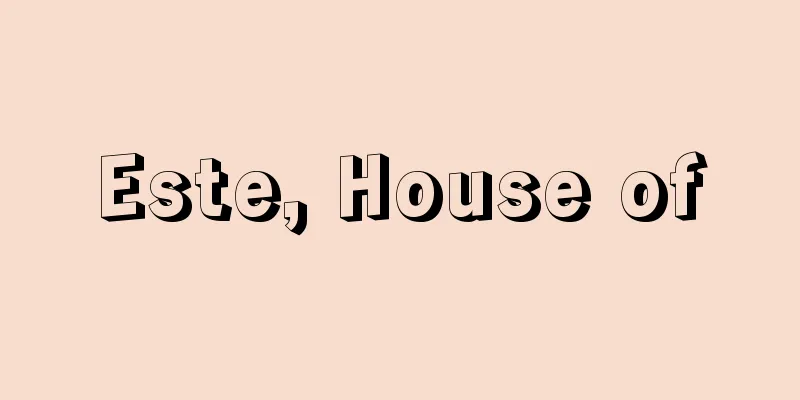Este, House of

|
A powerful aristocratic family that ruled the areas of Ferrara, Modena, and Reggio Emilia in central Italy from the Middle Ages to the modern era. Its ancestors date back to the Lombard nobles who fought against Berengar II, but the name Este was given to it by Alberto Azzo II (996-1097). Obizzo I (?-1193) began to expand his influence in the area when he married the daughter of a powerful family in Ferrara. Obizzo II (1240-93) became tyrant of Ferrara with the support of the Papal (Guelfi) coalition, and extended his influence to Modena and Reggio Emilia. In the 14th century, the family's political and cultural activities flourished, including the construction of the Este Castle and the founding of the University of Ferrara. In 1452, during the reign of Borso (1413-71), he was given the titles of Duke of Modena and Reggio Emilia by Holy Roman Emperor Frederick III, and in 1471 he was made Duke of Ferrara by Pope Paul II. Borso's younger brother Ercole I, who succeeded him, married his two daughters Isabella and Beatrice to Francesco Gonzaga, Duke of Mantua, and Ludovico Sforza, Duke of Milan, respectively, strengthening his ties with the most powerful families in Italy. His eldest son Alfonso I, who succeeded Ercole I, lost Modena and Reggio Emilia to the Pope for a time, but later regained them, and his son Ercole II married a daughter of King Louis XII of France. His son Alfonso II (1533-97) died without an heir, and in 1597 his cousin Cesare (1562-1628) became his successor, but Pope Clement VIII did not recognize his right of succession and confiscated the Duchy of Ferrara, ending the Este family's rule over Ferrara in 1598. After this, the family rapidly declined, but they retained the title of Duke of Modena, and in the 18th century Francesco III (1698-1780) was appointed Governor of Lombardy by Austrian Emperor Maria Theresa. In 1796, Ercole III was driven out of Modena by the French invasion, but Francesco IV (1779-1846) was restored to the throne by the Congress of Vienna, and in 1860, under his successor Francesco V (1819-75), the Duchy of Modena was annexed to the Kingdom of Sardinia, ending the Este family's rule. Source: Encyclopaedia Britannica Concise Encyclopedia About Encyclopaedia Britannica Concise Encyclopedia Information |
|
中世から近代にかけて中部イタリアのフェララ,モデナ,レッジョエミリアの諸地域を支配した有力貴族の家系。祖先はベレンガーリョ2世と争ったランゴバルド貴族にさかのぼるが,エステの名をもったのはアルベルト・アッツォ2世 (996~1097) からで,オビッツォ1世 (?~1193) がフェララの有力家の娘と結婚したのを機にその地に勢力を拡大し始めた。オビッツォ2世 (1240~93) は教皇派 (グェルフィ) 連合の支援を得てフェララの僭主となり,勢力をモデナ,レッジョエミリアにまで広げた。 14世紀にエステ城建設,フェララ大学開設など一門の政治的・文化的活動はとみに盛んとなり,ボルソ (1413~71) の代の 1452年に神聖ローマ皇帝フリードリヒ3世からモデナ公,レッジョエミリア公の称号を与えられ,さらに 1471年にローマ教皇パウルス2世からフェララ公に叙せられた。ボルソの跡を継いだ弟のエルコレ1世は二人の娘イザベラとベアトリーチェをそれぞれマントバ侯フランチェスコ・ゴンツァガとミラノ公ルドビコ・スフォルツァに嫁がせてイタリアの有力家系との結びつきを強めた。エルコレ1世を継いだ長男アルフォンソ1世は教皇によって一時モデナとレッジョエミリアを奪われたが,のち回復,その子のエルコレ2世はフランス王ルイ 12世の娘と結婚した。その息子アルフォンソ2世 (1533~97) は嗣子なしに没し,1597年従弟のチェーザレ (1562~1628) が後継者となったが,教皇クレメンス8世は相続権を認めずにフェララ公国を没収したため,エステ家のフェララ支配は 1598年に終わった。こののち家系は急速に衰えるが,モデナ公の地位は保ち,18世紀フランチェスコ3世 (1698~1780) はオーストリア皇帝マリア・テレジアによってロンバルディア総督に任じられた。 1796年フランス軍の侵入でエルコレ3世はモデナを追われたが,ウィーン会議によりフランチェスコ4世 (1779~1846) が復位し,次のフランチェスコ5世 (1819~75) の代の 1860年にモデナ公国のサルジニア王国併合が決まり,エステ家の支配は終了した。
出典 ブリタニカ国際大百科事典 小項目事典ブリタニカ国際大百科事典 小項目事典について 情報 |
Recommend
reckless
…Such cases can occur in all crimes, but the ones...
Mallarmé - Stéphane Mallarmé
A poet who was revered as the mentor of French Sy...
Kasuri thread
…The etymology is from the Malay word mengikat, w...
Asian skunk cabbage - Asian skunk cabbage
A perennial plant of the Araceae family (APG clas...
Stella, F. (English spelling) StellaF
...It is considered part of the lineage of abstra...
Amiudo - Amiudo
〘Noun〙 (a variation of "amibito") ※Heike...
Alcock, JW
...He died when landing at his destination), foll...
Najah (English spelling)
...The Ismailis became active from the end of the...
Group f64
…He studied photography under C.H. White (1871-19...
Murayama Matasaburo
Year of death: 1652.4.14 (1652.4.14) Year of birth...
Uighur Kingdom
…In 640 (the 14th year of the Zhenguan period, th...
Shrouded in mystery
〘 noun 〙① Curtains and curtains. Hanging curtains ...
Ta Thu Tau (English spelling)
?-1945 A Trotskyist communist active in southern V...
Chelate
Also called a chelate compound. A compound in whi...
Alstroemeria pulchella (English spelling) Alstroemeria pulchella
…[Tora Saburo Kawabata]. … *Some of the terminolo...









